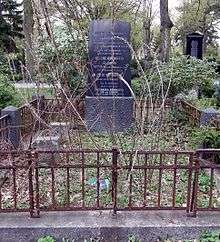Richard Börnstein
Richard Börnstein (9 January 1852, in Königsberg – 13 May 1913, in Berlin) was a German physicist and meteorologist.
He studied natural sciences at the University of Göttingen, and later on, worked as an assistant to Georg Hermann Quincke at the University of Heidelberg. In 1877 he obtained his habilitation at Heidelberg, and afterwards taught classes in experimental physics and meteorology at the Agricultural Academy in Proskau. From 1881 onward, he served as a professor at the Agricultural University of Berlin.[1][2]
At the university in Berlin he established a meteorological station. He is also credited with the development of a pressure anemometer (1883) and making improvements in regards to rain gauge methodology.[2][3] In 1883, with chemist Hans Heinrich Landolt, he published the first edition of the Physikalisch-Chemische Tabellen (now referred to as the "Landolt-Börnstein"; it presently contains more than 400 volumes of data from all areas of the physical sciences).[4]

Selected works
- Der Einfluss des Lichtes auf den elektrischen Leistungswiderstand von Metallen (habilitation thesis, 1877) – The influence of light on the electric power resistance of metals.
- Unterhaltungen über das Wetter, 1905 – Conversations about the weather.
- Sichtbare und unsichtbare Strahlen, 1905 – Visible and invisible rays.
- Die Lehre von der Wärme, 1907 – The theory of heat.
- Leitfaden der Wetterkunde, 1913 – Guide of meteorology.
He also made contributions to Richard Assmann's Wissenschaftliche Luftfahrten ("Scientific balloon rides", 1899–1900).[5][6]
References
- ↑ Aachen - Braniß / edited by Rudolf Vierhaus Deutsche Biographische Enzyklopaedie
- 1 2 Börnstein, Richard Leopold, Meteorologe In: Neue Deutsche Biographie (NDB). Band 2, Duncker & Humblot, Berlin 1955, ISBN 3-428-00183-4, S. 406.
- ↑ Report of the Board of Regents, Volume 1884
- ↑ Landolt-Börnstein
- ↑ Richard Börnstein de.Wikisource
- ↑ Friedr. Vieweg & Sohn Verlagskatalog: 1786–1986 by Frank Lube